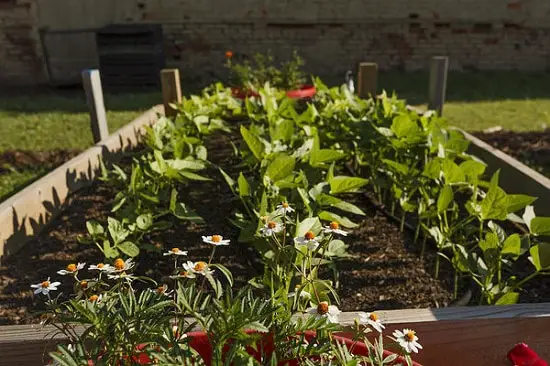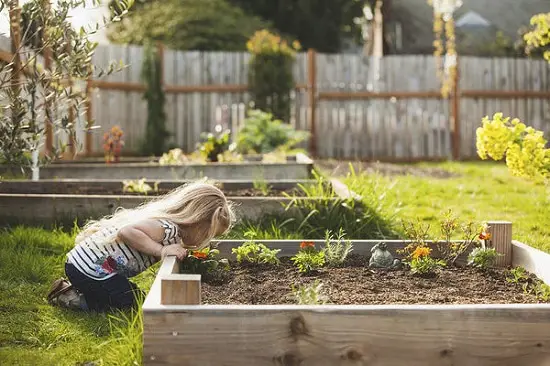Wondering What Are Raised Beds and how you can use them to grow Vegetables and Flowering Plants? Read all the details here!
Raised beds are planter boxes made from wood, stone or concrete, in a rectangular or curved shape. Its an enclosed arrangement filled with soil rich in organic matter for growing vegetables, fruits, and flowering plants. Let’s discuss What are Raised Beds and how you can make one or many in your garden!
Have a look at raised bed gardens for the balcony here
Requirements for Making Raised Beds
1. Soil
The soil for raised beds should be well-draining but also have some water-retaining capacity. Loamy soil with a proper mix of sand & clay that is rich in organic matter like peat moss, compost, ground bark or sawdust is good for this purpose. You can also take one-fourth sand, one-fourth topsoil, one-fourth peat moss or coco peat, and one-fourth compost or manure. Mix all the ingredients thoroughly before use.
2. Location
Select a spot that is leveled and receives at least 6-7 hours of sunlight, as most vegetables require full sun. If sunlight is scarce in your yard, you can grow vegetables that can grow in shades–Root vegetables and greens are good for this purpose.
3. Size
Keep the width at 4-5 feet, and avoid making it any bigger otherwise, weeding, mulching, and harvesting will become difficult. The length can vary from 8-12 feet, while the depth should be 6-12 inches, as more than that will ask for more soil, hence will increase cost and labor.
Note: You can build an 18-24 inches wide path between two ends for better management. Also, you can keep the height of raised beds till waist if you have a back problem.
Materials for Making Raised Beds

1. Wood
For making the bed, you can choose redwood or black locust that survive up to 20 years and are rot-resistant as well. Cedar is another rot-resistant wood, which serves up to 10-15 years. Teakwood is also an option. You can also opt for douglas fir or hemlock, having a lifespan of 5-7 years. They are also inexpensive and affordable.
Note: Avoid pressure-treated woods, as there can be a risk of leaching the arsenic into the soil, which is poisonous.
2. Stone or Concrete
If you don’t want to use woods or logs, you can make raised beds from stones and concrete as well. Stone raised beds offer a strong foundation and are also weatherproof; hence they are preferred over the wooden beds. Brick raised bed with or without cement are also a longlasting and affordable option.
Building the Raised Beds

- Make a layout of the raised bed with a hose.
- Use stake and strings to mark the edging of the raised beds. Hammer the stakes at the midpoint of the timber plank using a mallet. Make sure they are leveled.
- Place the planks by keeping them supported with stakes.
- Check if all planks are the same in height or not, and use a driller and screw for joining overlapped timber planks with each other.
- You can add up an additional row by bolting it at stakes.
Looking for interesting raised bed ideas? Click here!
How to Fill a Raised Garden Bed

Prepare the soil recipe explained above. Mix them using a spade and remove any stone or rock present in the mixture. Fill this mixture till the brim of the bed.
Alternatively, you can also use the lasagna method, fill the half bottom layer of the bed with organic materials like shredded bark, grass clippings, or rotted manure, and spread it uniformly. Then, place cardboard or newspapers over this layer, and top it up with soil.
Planting in Raised Beds

Grow tall plants at the center, and small plants near the edge, so that they can also avail the full sun.
For sowing seeds directly, poke the finger in the soil and make tiny holes. Sprinkle the seeds of vegetables or flowering plants in the holes and cover them with fine-textured potting soil. Finally, water that area thoroughly and keep the soil moist until the seeds are germinated.
Care of Plants in a Raised Bed Gardening
1. Mulching
Use pine needles, bark, salt hay, and well-dried grass clippings. It helps in preventing water loss from the soil and also protects the roots. For vegetables like tomatoes, eggplants, and melons, use black plastic mulch.
Tip: Mulch the soil at least 2-3 inches deeper, keeping it at least one inch away from the plants’ stems.
2. Watering
Soil in raised bed dries out much quicker than a regular garden bed due to better drainage. You can check if the plants need water by poking your index finger in the soil till a couple of inches. If it feels dry, water it. During summer, you may need to water more often.
Tip: You can also use a drip or sprinkler system for watering the raised beds plants.
What to Plant in Raised Beds?

You can grow container fruits, vegetables, and flowering plants in the raised beds. Best Vegetables to Grow in raised beds are root vegetables like onion, tomato, potato, carrot, and leafy vegetables like lettuce, spinach, and kale. Also, you can grow fruits like strawberries, raspberries, blackberries, and flowering plants like daylilies and lavender in raised beds.
Benefits of Raised Garden Beds
- The soil warms up sooner than normal garden bed soil during spring, hence facilitating earlier planting and longer growing season.
- Thanks to the limited space, the maintenance of soil, watering, and fertilizing is controllable, facilitating the harvesting.
- It also provides better drainage, giving plants’ roots enough room to breathe.
- As plants are at a raised surface, they will be safe from someone walking over them.
- You can amend the soil easily as the space is limited and you can do it more frequently.
- If you’ve got a back problem, raised beds are perfect for you. As they can also be of waist-height, they’re also good for elderly people.




